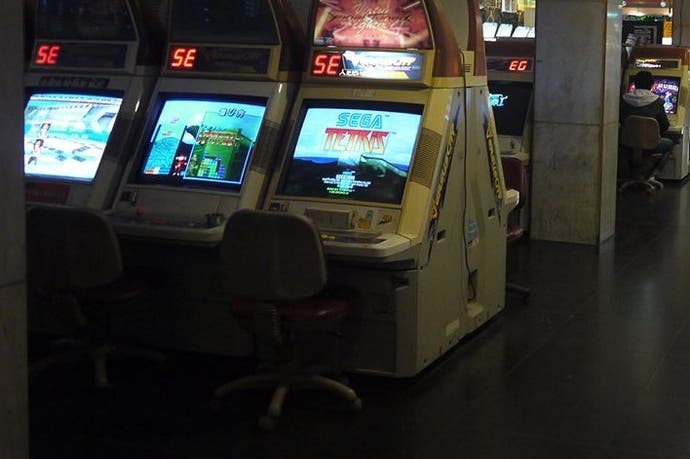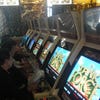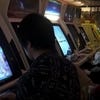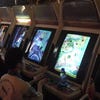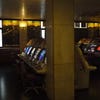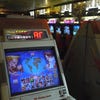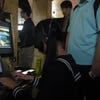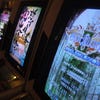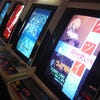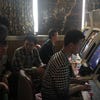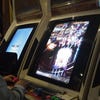Inside Shanghai's hardcore gaming heartbeat
The last arcade.
I've never missed a flight before, although I once came close in Seoul after mistakenly assuming Incheon city and Incheon airport were in the same place. If I hadn't found an old taxi driver willing to bomb it across the yellow sea on a futuristic cable-stayed bridge, break-rolled through the terminal entrance and Marty McFlew on a luggage trolley into a closing check-in, I may not have made it. But I did.
Attending a wedding the evening prior to my Shanghai flight seemed like a fine idea at the time. Knowing I would be accosted by strangers for ultra combo-drinking I sensibly set my phone's alarm well in advance. Following the crowd from the wedding site to a karaoke bar, and then eventually back home custodian of a well-defined drunken stupor, I successfully overlooked how much battery was remaining on my three-year old Samsung handset. Evidently, when I opened my eyes the following morning at precisely the time my flight was leaving the runway, I realised the answer was not enough.
I contemplated calling the whole thing off. Was I really going to buy another ticket just to spend two days playing games in an arcade?
The following afternoon I touched down in Shanghai. A dense metropolis populated by almost as many old-world artifacts as it is new, the city's historical remnants turned monuments are beautifully preserved in an ever developing urban sprawl. One side of The Bund houses a financial hive of cobalt steel gangways and skyscrapers battling for the world's-tallest placard, while opposite an ostentatious post-opium war promenade reminds of the British-led foreign occupation that saw the city commercially drawn and quartered in the late 17th century.
Today it still beats with the influence of those times. A fusion of enterprises of the past, the French Concession, art deco movie theatres, and an omnipresent European cultural influence dilute anything typically Chinese.
Inspiring an assembly as it is, sightseeing will have to wait: I have games to play. Opposite the derelict Majestic Theatre, itself a paragon of Shanghai's architectural eclecticism, is an unassuming building with a fourth floor still kicking it like it was 1995.
China may be doing well in terms of game centres - there are plenty around - but any surviving old-school fixtures are heavily outnumbered by redemption grabbers and K-Pop rhythm games clawing back the overhead.
Lie Huo arcade, however, is a remarkable exception; a place where the clock stopped, condemning it to a future as China's foremost classic gaming hangout and a haven for the hardcore circles that embrace it.
A magnificent CRT spectrum accompanied by an overture of coin drops and button taps, its staggered waves of Blast and Versus City cabinets rival the best of Japan's corresponding establishments. Joining various light gun, rhythm machines, and the obligatory King of Fighters rally - a permanent fixture in any Chinese arcade - is a set of eight Daytona cabinets, everything Street Fighter, Tekken, Samurai Spirits, Captain Commando, Cadillacs and Dinosaurs, Guilty Gear, Tetris Grandmaster, Puzzle Bobble, and plenty of Mahjong for the chain smokers.
The back-left corner houses an area dedicated to shooting games - or STGs to use the Asian acronym - where players drawn from Jiangxi, Xi'an, Shenzhen, Changsha and Hangzhou are joining Shanghai's local team for a 48 hour bullet-fuelled marathon; while a group dedicated to Touhou - the works of amateur developer ZUN - are demonstrating various challenges on two nearby laptops.
If you don't know STGs - better recognised in the west as shoot-em-ups or shmups - it's that arcade born, typically 2D genre where spaceships fly horizontally or vertically wiping out assailants and weaving through incoming fire. Although STGs have come a long way since the heyday of Space Invaders and R-Type, it was a genre holding on for dear life until developer Cave's recent 'bullet hell' renaissance: a style pioneered by their chief programmer, Tsuneki Ikeda, and his former employer, Toaplan.

For most, Cave's articulate blend of deep and rewarding scoring systems married to hammer-hard, take-no-prisoners challenge make their output the crème of the modern scene. With aftermarket arcade PCBs prohibitively costly thanks to passionate collectors, it's thrilling to see Mushihimesama Futari Black Label sitting alongside DoDonpachi DaiOuJou Black Label, DoDonpachi SaiDaiOuJou, Espgaluda 2, Ketsui, Deathsmiles Mega Black Label and DoDonpachi DaiFukkatsu 1.5. Other headliners include Treasure's Ikaruga and a handful of Psikyo favourites.
When asked how Lie Huo came about such an impressive assembly, Chris, host and moderator for China's online STG scoreboard, tells me that the arcade once had a technician who was a fan of the genre.
"He started working here when Lie Huo opened in 2004 and gradually introduced STGs to the arcade. His contributions were responsible for building a community that didn't really exist before. Now Lie Huo is number one for STGs in China."
That said, Lie Huo meetings are still something of a luxury. When I ask how Chinese players feel about arcade emulation, he tells me serious score hunters won't accept MAME as an option.
"It just doesn't feel 100 per cent compared to the actual arcade board. So unless we're lucky enough to have access to an arcade, dedicated PC STGs where high scores can be set on a level playing field - such as Crimzon Clover on Steam - get a lot of attention."
The enthusiasm and range of tastes among the crowd is uplifting. DoDonpachi DaiFukkatsu diehard Zhou Muzhen, who even came wearing the shirt, quickly settles down to play some Power Style, while Gradius and Salamander fan Yu Haotian tells me how he's joined the ranks of those seduced by Dariusburst AC, Taito's full-scale, four-player arcade epic. "I love it. The atmosphere is really incredible," he says. When asked about the recent rumour of a PS4 port that surfaced on shmups.com, he's pessimistic. "I don't think it will happen," he laments. I tell him to have faith.
Liusha from Hangzhou, into Psikyo games and sporting a Stallone-style physique, assures me he didn't build his impressive biceps playing Strikers 1945, while Chen Fanzhi, a hardcore Jubeat player (part of Konami's Bemani series), admits he often plays games on his mobile phone when the arcade doesn't have anything on offer. "Lie Huo isn't great for Rhythm games, but it does have the only Taiko no Tatsujin (Namco's popular drum machine series) version 14+ in the whole of China."
A sort of gentlemen's club turned gaming wonderland, the one thing most difficult to fathom in Lie Huo's cosy den of drawn curtains, peeling decor and phalanx of screens, is the price: one Yuan for two game tokens. That's approximately five pence a go, or sixty plays for three pounds.
When I ask about the future of the arcade, the guys admit they don't know how much longer it can hold on.
"Most arcades in China make money from gambling machines, which aren't legal. Operating in Shanghai's city centre is too dangerous for such things, so Lie Huo removed them all. Now we really aren't sure how it makes any money."
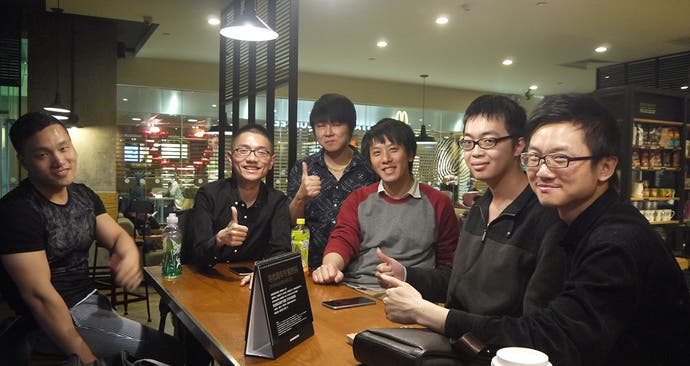
"We won't be sad," says local STG master WC, "We're prepared for its closure. It's inevitable. If there are no more STGs to play we'll all move on to different, more easily available genres."
When asked if they have considered supporting the place themselves, WC declares someone show him the money.
"There was one player who thought about buying some PCB's from Lie Huo," says Chris, "But it didn't come to pass. As an STG community we will have to either disband or move completely online."
Although the precarious fate of Lie Huo, a last stand for arcade gaming as we once knew it, is a story in itself, the undiscovered story of its players is even more potent.
By the end of the two-day meet I had found a comfortable spot on the floor to rest my jaw. And it wasn't that my humble collection of one credit-clears were expectedly upstaged in every possible respect, but that these players rival the best the world has ever seen and barely anyone knows they exist.
The largest western STG community can be found on shmups.com, home to a comprehensive and active list of score tables. With Japan's super players generally considered those to beat, it was startling to find China's group eradicating the best of the west's top scores while skating nail-bitingly close to current world records.
The three W's, as I affectionately refer to them, are a trio of Shanghai players that form the top of China's STG pile. WS was once considered the most talented before he lost interest and began dabbling in other genres. Nevertheless, I can scarcely believe my eyes when I see him double-playing Espgaluda 2 - double play being the art of using both Player One and Player Two characters simultaneously across both buttons and sticks. A display of daring dexterity more commonly practiced on the Raiden series, Espgaluda 2's system mechanics are so complex most seasoned double-players wouldn't even consider it - yet WS repeatedly dips into the game's lethal high scoring modes without batting an eyelid.
WC, who is quick to tell me his handle has nothing to do with a toilet, is one of the most entertaining players I've ever seen. Like a video gaming Ronnie O' Sullivan, his style is impulsive, erratic and thrilling, hunched over the screen with a cigarette dangling from his lips as he dances unscathed through the thickest of bullet storms. He knocks back DoDonpachi SaiDaiOuJou's expert mode - a matter of absolute violence from the word go - on repeat, joking casually with onlookers while ripping into the stage five overflow bug and pushing the scoreline to almost burst its boundaries.
Although our skill levels are worlds apart, I'm pleasantly surprised to find our tastes are about even. When I ask him what he considers the best and worst the STG genre has to offer, he instantly throws up DoDonpachi DaiOuJou.
"For me it's the best of all. Because its bullets have an organic nature, and the pressure of the second loop [which restarts the game at a much higher difficulty level and strips you of all your lives] is incredible. I think it's the most perfectly constructed STG ever made. It took me four years of playing on weekends to get the 2 loop clear, but I'm still trying to improve my score. My next goal is 1.8 billion."
And the worst?
"Definitely Ikaruga," he replies.
I can't help but smile. Treasure's avant-garde polarity switching game was once a darling of the mainstream press, but among STG circles its virtues have never been so black and white.
"It's just not really an STG," he continues. "It doesn't really play the same. There's not a lot of actual shooting going on."
I'm told China's best STG player is WY, who after making mincemeat out of Mushihimesama Futari's God Mode - akin to someone piloting through the world's most expensive firework display with nothing but a twinkling hit-box and millimeters of survival space - finally gives in to my request to show off his DaiOuJou skills.
The sun long set outside, empty bottles of ice tea and coffee littering control panels, nearby ashtrays a geographical landscape of butts, it's not just the weekend's final performance, but the performance to end all. WY takes out both loops of the game as if the relentlessly converging bullets - which by loop two are shutting down almost all available screen space - don't even exist. His precision at finding perfect paths through the hailstorm, so feared for its elements of unpredictability that French DoDonpachi super player Prometheus once labeled it as borderline unfair, is so exacting that he reaches the true last boss without losing a single life. Set not only to break his own high score of 1.8 billion but possibly the 2.2 billion world record, by this point I don't even know where the edge of my seat used to be. With a final boss that fires patterns too fast for the eye to follow, deaths are inevitable, but a single crucial mistake in failing to bomb costs the entire potential of the run. Still, by the time he gets up, 1.7 billion flashing at the top of the screen's scoreboard, I've all but forgotten how to speak.
"Next time," he says.
I believe it.
Over dinner in a nearby food court, I pitch Chris one nagging question. If China's STG players are so remarkable - and they are - why is it no-one knows about them, and why don't they do more to promote themselves on the global stage? "I'll tell you," he says, as if about to reveal an under-the-table secret. "In Chinese culture, keeping a low profile is considered sensible and safe. Chinese people tend to shy away from exposure, because attracting attention can also attract trouble. So we're happy to just share our achievements among ourselves."
That said, I have a feeling there is some underlying desire to connect with the wider world, especially when WC asks me if I think Chinese players could ever be invited to Stunfest, a French STG event famous for flying in some of Japan's best. I tell him I don't know, but I'm damn sure they should be.
After dinner we stop short of the STG back-corner basecamp for something altogether different. "Play Tank Force!" they shout, ushering me to a row of eight cabinets featuring an old Namco horde-style defense game from 1991, where up to four allied tanks hold their ground against incoming enemies by utilising destructible terrain and obstacles across a series of fixed maps.
They have obviously played it before, instantly ordering me into safe positions and telling me to sit tight and fire down select corridors, or to run and grab various power-ups. By the time we clear the entire game, it's been fifteen minutes of laughter. Laughing at the urgency, the end of stage scores, at tense near-death moments and all those comedy errors.
No headsets. No bedroom captivity. Just four guys side-by-side, video gaming. Where a relatively unremarkable piece of software can become a memorable event is a powerful reminder of the arcane magic contained within an arcade's walls. On the day when Lie Huo's final CRT tube dies out and the place falls silent forever, I'll remember the best of it until I go the same way.
